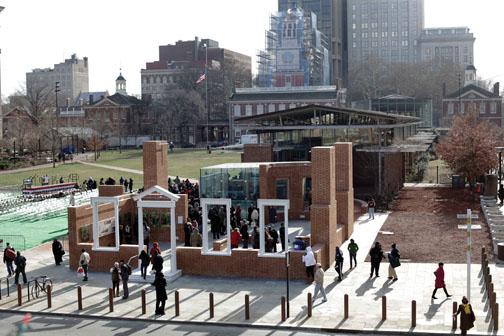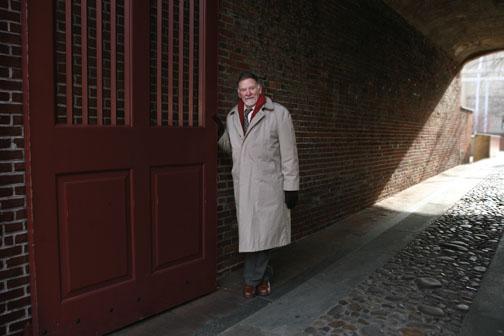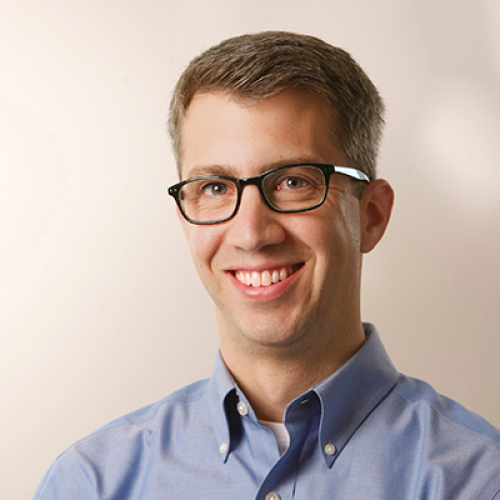The opening of an outdoor historical exhibit in Philadelphia in the middle of December, with the wind swirling and temperatures well below freezing, might not seem like a major draw. But Gary Nash ’55 *64 could not miss it, and he flew in from California to attend.
The event unveiled the new open-air installation at the site where the President’s House once stood, one block north of Independence Hall — the home of George Washington and John Adams during the city’s time as capital of the United States. Eight years earlier, Nash, a distinguished historian of early America and professor emeritus at the University of California, Los Angeles, had raised awareness of the nearly forgotten piece of land, rallying a handful of historians and community leaders to the cause of preserving the site. The President’s House, they noted, represented an important dichotomy illustrative of the nation’s formative years: Washington kept slaves during his time in Philadelphia. The slave quarters, in fact, once stood on the piece of land where visitors today enter the pavilion housing the Liberty Bell. The exhibition, on the footprint of the original mansion, acknowledges this juxtaposition of slavery and liberty with a critical but commemorative exploration.
(This is a corrected version of an article published in the Feb. 9, 2011, issue. The correction appears at the end of the story.)
“It’s hard to be honest about some of the ambiguities and paradoxes of our history,” Nash says, “and I think the public — they’re going to learn a lot.
“They’re not going to be embarrassed to be American,” as some critics of the exhibition have suggested, he continues. “It’s great that, in a mature democracy, we can look at this question of how freedom and slavery were joined at the hip.”
A few decades ago, it would have been unusual to see a National Parks Service project address this multidimensional, scholarly view of history, just as it would have been rare for an academic with Nash’s credentials to serve as a booster for “public history.” But Nash, the longtime director of UCLA’s National Center for History in the Schools, and others in his generation — including Princeton historians Theodore Rabb *61 and James McPherson — have worked to extend the academy’s reach, helping to establish links between academia and the public and taking a keen interest in the work that history teachers do in America’s classrooms.
American educators have long acknowledged that there is significant room for improvement in history instruction. Asking what U.S. students know about history — or what don’t they know — tends to produce some cringe-inducing answers, particularly when it comes to basics like historical chronology. For instance, in a 2008 survey, Common Core, a nonprofit group that aims to broaden the core curriculum in schools, found that less than half of 17- year-olds surveyed could place the Civil War in the right half- century, and a quarter thought Columbus sailed after 1750.
The Department of Education’s National Assessment of Educational Progress, known as the nation’s report card, provides a slightly more encouraging outlook. The most recent report, in 2007, indicated overall improvements in the three grades surveyed — fourth, eighth, and 12th — compared with data from 1994 and 2001. The gains came mostly in the number of students who exhibited “basic” knowledge, while the proportion of “proficient” or “advanced” students remained virtually flat. (Examples of basic knowledge for high-school seniors included identifying an important idea of Lyndon Johnson’s Great Society programs; advanced students were able to explain the importance of the Connecticut Compromise and the reasons for America’s involvement in the Korean War.) Proficiency decreased as students advanced in school, and less than half of high school seniors performed at or above the “basic” level. Data from the latest round of tests, conducted last year, will be released this spring.
In the last few decades, classroom teachers have seen increasing support from historians in the academy. Rabb, a Princeton professor emeritus and expert in English history, began to take a deeper interest in history education in the 1980s when he was part of a team of scholars that explored the teaching of history for a project sponsored by the Lynde and Harry Bradley Foundation. After finishing their work, the scholars and teachers involved in that group founded the National Council for History Education (NCHE), which Rabb later chaired. In its early years, the organization lobbied against efforts to reduce state requirements for the time spent on history in the classroom; today, NCHE supports classroom teachers and promotes the “habits of the mind” that history can instill.
Nash’s interest in the schools also was born in the 1980s, but his view of history — in particular, social history — developed earlier, in the years after he earned his Ph.D. from Princeton. An expert in Revolutionary and colonial America, he had written about the roles that Quaker leaders played in Philadelphia politics, but at the same time, he began to believe that historians were taking a narrow view of the past. “A narrow political history is a distorted history,” he later explained in an interview with the website HistoryAccess.com. “A more sweeping history is more objective, more true, taking into account the tremendous diversity of people, regions, religions, and so on in this country.”
During his early years at UCLA, in the late 1960s and early 1970s, Nash spent summers researching Philadelphia, New York, and Boston in the time leading up to the American Revolution. He set his sights on neglected sources — probate records, almshouse admissions, and vagrancy dockets — to tell the stories of a broad swath of colonial Americans, not just the founding fathers.
The documents had remained “virtually untouched” for 200 years, Nash says. His work was tedious. Long before Excel spreadsheets, working in dusty city archives that did not offer the luxury of photocopies, he had to compile his findings in handwritten notes. But he took to it. “I really became intoxicated with the idea of trying to unearth the lives of people at the lower lev els of society and what difference that made,” he says.
The work put Nash on the leading edge of social history, and one of the books that followed, The Urban Crucible: Social Change, Political Consciousness, and the Origins of the American Revolution, earned a Pulitzer Prize nomination in 1979. The book explored how economic, political, and social shifts in the 18th century turned America’s colonial seaports into “crucibles of revolutionary agitation.” Thirty years after its publication, Princeton history professor John Murrin wrote in the Pennsylvania Magazine of History and Biography that The Urban Crucible “remains a triumph” and called the depth of Nash’s research “amazing.”
For Nash, history could be transforming, a force for change — but he soon realized that high school students often didn’t see it that way. In the mid-1980s, working on a college textbook that blended social and political history, he took a closer look at the texts used by Advanced Placement courses in high schools. He found a stagnant school curriculum that incorporated little of the new perspectives on the history of women, African-Americans, and other groups previously overlooked by scholars. The disconnect between academic historians and the teachers working in the nation’s classrooms was a big part of the explanation, he believed — and part of the reason American students performed so poorly in history.
“For years and years, we lived on opposite sides of the Grand Canyon — we would barely see each other, and we couldn’t hear each other,” he says. “We never found a way of building a bridge.” Academics tended to believe in a trickle-down effect: Scholarly books and college textbooks would be read by those who write high-school or middle-school texts, who then would incorporate the latest scholarship into each new edition. But that, Nash says, wasn’t happening.
At the same time, momentum was growing for national standards in a handful of core curricular areas. When the National Endowment for the Humanities and the Department of Education launched a project to develop voluntary standards for the teaching of history in American elementary and secondary schools, Nash’s UCLA center earned a major grant to lead the process.
The work, conducted primarily over three summers, brought together dozens of top classroom teachers from around the country and academic experts from every era of American history and several fields of world history. Working groups lived in dorms at UCLA, dined together, and bonded over discussions and debates about history. The energizing intellectual environment became, in Nash’s view, “the greatest bridge-building construction job in the history of U.S. history” to that point.
But the standards that the group drafted became embroiled in a controversy initiated by Lynne Cheney, who had been chairwoman of the National Endowment for the Humanities when it awarded part of the funding for the project, and placing Nash in the center of the so-called history wars. Cheney, in a 1994 Wall Street Journal op-ed, cast the curricular guidelines as a study in political correctness, dubbing the effort “the end of history” and calling on Americans “to go up against an academic establishment that revels in the kind of politicized history that characterizes much of the National Standards.”
Cheney and other critics argued that by presenting a multicultural view of history, the standards pushed aside great individuals like George Washington and founding principles like those outlined in the Constitution. Nash and his colleagues responded by trying to explain the guidelines in detail. Over the course of two years, they endured passionate critiques and ad hominem attacks (some of which are described in History On Trial, a 1997 book that Nash wrote with Charlotte Crabtree and Ross Dunn, two colleagues from the standards project). “He took abuse that nobody should have to take,” says Princeton professor Stanley Katz, a friend of Nash. “It was a bruising personal experience.”
Even after the backlash, the standards found an audience, with more than 100,000 copies ordered by school districts and teachers in the decade that followed. But the episode confirmed what Nash says he had begun to believe even before the headlines and TV interviews: “If historians can’t reach the public about what history is and what the historian’s craft is, there will come a time when they’re going to pay for that disconnectedness.”

In the decade and a half since the controversy over the standards, Nash has not stopped trying to enliven classrooms with the best of what scholars have to offer. He has immersed himself in programs that provide professional development for history teachers, sharing his expertise on early America. Interaction between history scholars and schoolteachers has grown significantly in the last decade, thanks in large part to an extensive federal grant program for teacher development, and Nash believes that changes are taking hold. “Everywhere I go, the teachers are super-enthusiastic about it,” he says. “They see themselves changing in the way they think about history and try to get kids engaged in it.”
Nash has approached his work on history education with the same long-term determination that he showed in his archival research on colonial America. He became a tireless advocate of professional development, leading teachers in classes about American history and tours of historical sites. There is precedent for the work: Just before the turn of the 19th century, a group of progressive academics known as “the New Historians” — including Woodrow Wilson 1879 — played a prominent role in shaping history’s place in the curriculum of public schools, and in the decade before World War II, the American History Association, dominated by university professors, published more than a dozen volumes or reports on the teaching of “social studies” in the schools.
Recent efforts by Nash and other historians have had the benefit of great timing: Professional development received an enormous boost in 2001 when the Department of Education began awarding its Teaching American History grants, created by West Virginia Sen. Robert Byrd. Through 2010, the program has spent more than $1 billion “to raise student achievement by improving teachers’ knowledge and understanding of and appreciation for traditional U.S. history.”
Princeton’s engagement in the Department of Education grants has been spearheaded by the James Madison Program in American Ideals and Institutions, a co-sponsor of five current Teaching American History programs for New Jersey teachers. The Madison Program is directed by Robert P. George, the McCormick Professor of Jurisprudence and a well-known conservative thinker, and while George and Nash may occupy divergent positions on the political spectrum, they have similar views on why professional development matters in history education. A richer understanding of subject matter, George says, can give teachers a valuable boost. “An inspired teacher inspires his students — it’s that simple,” he says. “And what we’re in the business of is inspiring teachers in the best possible way, by enhancing their understanding of the content of the subject.”
Brad Wilson, executive director of the Madison Program, says that faculty members — both from Princeton and from other institutions — have accepted nearly every invitation he’s made to speak to teachers, and feedback about the programs, compiled by independent evaluators, has been “very gratifying.” “In so many cases, the teachers say that this is the best professional-development program that they’ve ever been part of,” Wilson says.
Others at Princeton support the effort. McPherson, a Pulitzer Prize-winning Civil War historian, has been a frequent lecturer in Teaching American History seminars at Princeton and elsewhere. He also serves as an adviser to the Gilder Lehrman Institute of American History, a nonprofit that supports American history studies, with a strong emphasis on K-12 education. Scholars have an obligation to share their knowledge with broader audiences, McPherson says, “partly to produce a better-informed and educated citizenry, but also because there is, I think, a hunger out there for understanding of history.”
Still, in Katz’s view, universities are not doing enough to encourage or reward faculty engagement with schoolteachers. “It’s not a mainstream thing to do, particularly in an elite research university,” he says.
Nash acknowledges that not everyone takes an interest in K-12 education. Some are more comfortable in a graduate seminar room, he says, and that’s fine. Compared to 10 or 20 years ago, there are far more historians taking an interest in the schools — and that, in Nash’s view, is progress. “It’s only a minority who are involved,” he says, “but that’s a very important minority.”
Still, the latest bridge-building movement could face barriers in the near future. The 2011 fiscal-year federal budget merges the Teaching American History grants into a broader Department of Education program devoted to several subjects — arts, foreign languages, civics and government, history, geography, environmental literacy, economic and financial literacy — and with the death of Sen. Byrd, historians have lost their greatest congressional ally. “He was a man who would quote Thucydides on the Senate floor,” says Rabb, who worked with Byrd during his term as the NCHE chairman. “This is someone who really believed in the importance of history. Now, it’s mainly lip service.”
Nash has additional concerns — particularly about the teaching of world history — but he remains optimistic. He sees promise in recent projects he has been involved with, including the National Park Service’s campaign to engage youngsters, dubbed “no child left inside”; a history-themed program at a Los Angeles high school that’s helped to reduce students’ dropout rate and increase their test scores, both in history and in other subjects; and the President’s House exhibit, which Nash says was driven as much by civic engagement as it was by those from the history profession.
The most promising signs come from young academic historians, who Nash says view public engagement as “part of their portfolio” — a distinct contrast to the prevailing attitude when he began his Ph.D. studies in the late 1950s. “I think it’s a very exciting time to be a historian,” he says. “And I think that most people do agree that history matters.”
Brett Tomlinson is an associate editor at PAW.
For the record
John Adams did not hold slaves during the two years that he lived in the President’s House. The original version of this story said that both Washington and Adams kept slaves during their time in Philadelphia.



